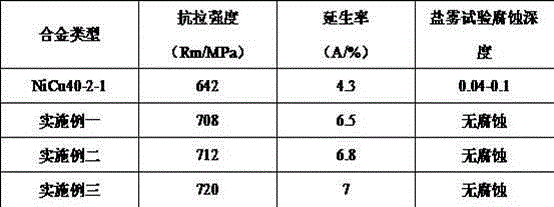Manufacturing technique of nickel-copper alloy
A manufacturing process and technology of nickel-copper alloy, applied in the field of nickel-copper alloy and its manufacturing process, can solve the problems of inability to achieve corrosion resistance effect, unsatisfactory effect of nickel-copper alloy, etc., and improve high-temperature oxidation resistance and corrosion resistance. , The effect of improving the metallographic structure and enhancing the compactness
- Summary
- Abstract
- Description
- Claims
- Application Information
AI Technical Summary
Problems solved by technology
Method used
Image
Examples
Embodiment 1
[0017] A manufacturing process of nickel-copper alloy, which mainly includes the following components, expressed in weight percentage: 35% copper, 15% iron, 15% chromium, 2% rhenium, 2.25% manganese, and 0.2% silicon , magnesium is 0.1%, titanium is 0.15%, nickel is 30%, and the rest is other ingredients.
[0018] The specific manufacturing process is as follows:
[0019] (1) Retrieving materials: select nickel, copper, iron, chromium, rhenium, manganese, silicon, magnesium and titanium as raw materials to prepare alloy materials according to the stated ratio;
[0020] (2) Smelting: Put nickel, copper, iron, chromium, rhenium, manganese, silicon, magnesium, and titanium into the melting furnace in sequence. The specific operation steps: first add nickel, copper, iron, and chromium to melt, and then Add rhenium, manganese, silicon, stir with electromagnetic, finally add titanium, magnesium, sample and cast;
[0021] (3) Annealing: steel ingot annealing temperature 1150°C--110...
Embodiment 2
[0026] A manufacturing process of nickel-copper alloy, which mainly includes the following components, expressed in weight percentage: 50% copper, 8% iron, 10% chromium, 0.5% rhenium, 2% manganese, and 0.15% silicon , magnesium is 0.05%, titanium is 0.1%, nickel is 29%, and the rest is other components.
[0027] The manufacturing process steps include the following operations in sequence:
[0028] (1) Retrieving materials: select nickel, copper, iron, chromium, rhenium, manganese, silicon, magnesium and titanium as raw materials to prepare alloy materials according to the stated ratio;
[0029] (2) Smelting: Put nickel, copper, iron, chromium, rhenium, manganese, silicon, magnesium, and titanium into the melting furnace in sequence. The specific operation steps: first add nickel, copper, iron, and chromium to melt, and then Add rhenium, manganese, silicon, stir with electromagnetic, finally add titanium, magnesium, sample and cast;
[0030] (3) Annealing: steel ingot anneali...
Embodiment 3
[0035] A manufacturing process of nickel-copper alloy, which mainly includes the following components, expressed in weight percentage: 40% copper, 10% iron, 12% chromium, 1.5% rhenium, 2% manganese, and 0.17% silicon , magnesium is 0.06%, titanium is 0.12%, nickel is 34%, and the rest is other components.
[0036] The manufacturing process steps include the following operations in sequence:
[0037] (1) Retrieving materials: select nickel, copper, iron, chromium, rhenium, manganese, silicon, magnesium and titanium as raw materials to prepare alloy materials according to the stated ratio;
[0038] (2) Smelting: Put nickel, copper, iron, chromium, rhenium, manganese, silicon, magnesium, and titanium into the melting furnace in sequence. The specific operation steps: first add nickel, copper, iron, and chromium to melt, and then Add rhenium, manganese, silicon, stir with electromagnetic, finally add titanium, magnesium, sample and cast;
[0039] (3) Annealing: steel ingot annea...
PUM
 Login to View More
Login to View More Abstract
Description
Claims
Application Information
 Login to View More
Login to View More - R&D
- Intellectual Property
- Life Sciences
- Materials
- Tech Scout
- Unparalleled Data Quality
- Higher Quality Content
- 60% Fewer Hallucinations
Browse by: Latest US Patents, China's latest patents, Technical Efficacy Thesaurus, Application Domain, Technology Topic, Popular Technical Reports.
© 2025 PatSnap. All rights reserved.Legal|Privacy policy|Modern Slavery Act Transparency Statement|Sitemap|About US| Contact US: help@patsnap.com

